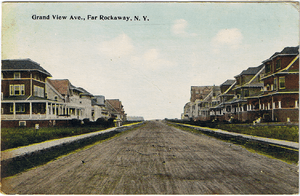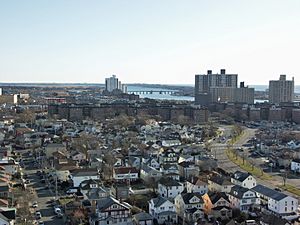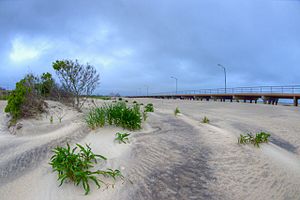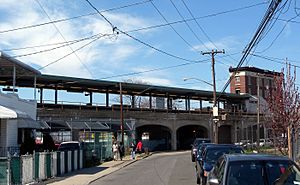Far Rockaway facts for kids
Quick facts for kids
Far Rockaway
|
|
|---|---|
|
Neighborhood of Queens
|
|
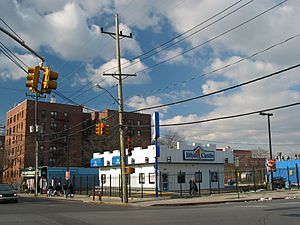
Far Rockaway in 2005
|
|
| Country | |
| State | |
| City | New York City |
| County/Borough | Queens |
| Community District | Queens 14 |
| Named for | Place name of the Native American Lenape. |
| Population
(2010)
|
|
| • Total | 50,058 |
| Ethnicity | |
| • Non-Hispanic White | 25.5% |
| • Black or African-American | 44.7% |
| • Hispanic or Latino of any race | 24.7% |
| • Asian | 1.9% |
| • Other | 1.4% |
| • Two or more races | 1.7% |
| Economics | |
| • Median income | ,820 |
| Time zone | UTC−5 (EST) |
| • Summer (DST) | UTC−4 (EDT) |
| ZIP Code |
11691, 11693
|
| Area codes | 718, 347, 929, and 917 |
Far Rockaway is a neighborhood located in the eastern part of the Rockaway peninsula in Queens, a borough of New York City. It is the easternmost section of the Rockaways. The neighborhood stretches from Beach 32nd Street all the way to the border of Nassau County. To the south, it meets the Atlantic Ocean, making it one of the neighborhoods along Rockaway Beach.
Far Rockaway is part of Queens Community District 14. Its main postal codes are 11691 and 11693. The New York City Police Department's 101st Precinct keeps the area safe.
Contents
History of Far Rockaway
Early Days and Land Sales
The first people to live in the Rockaways were the Canarsie Indians. They were a group of Mohegan who gave the area its name. In 1639, the Mohegan tribe sold most of the Rockaways to the Dutch West India Company.
Later, in 1664, the English took control from the Dutch. In 1685, the Mohegan chief, Tackapoucha, and the English governor agreed to sell the Rockaways to Captain Palmer for 31 pounds.
The Rockaway Peninsula was first part of the Town of Hempstead in Queens County. Captain Palmer later sold the land to Richard Cornell in 1687. Cornell and his family lived on a homestead near the Atlantic Ocean.
How Far Rockaway Grew in the 1800s
In the late 1800s, the Rockaway Peninsula became a popular summer spot. A group called the Rockaway Association built a large hotel called the Marine Pavilion. Famous guests like Henry Wadsworth Longfellow and the Vanderbilt family stayed there. The association also built the Rockaway Turnpike. Even though the Marine Hotel burned down in 1864, more hotels and homes were built.
Travel to the Rockaways was slow at first, using horse-drawn carriages or ferries. But in the 1880s, the Long Island Rail Road built the Rockaway Beach Branch. This train line connected Far Rockaway to other parts of New York. This made the area grow quickly, and by 1888, Far Rockaway became a village.
Far Rockaway in the 1900s and Today
In 1898, Far Rockaway became part of the City of Greater New York. The area faced tough times during World War I and the Great Depression. After World War II, new apartment buildings were constructed. However, the building of public housing and hospitals in the 1960s changed the neighborhood's image.
In 2017, the New York City Council approved a plan to redevelop 23 blocks in Far Rockaway. This plan allows for new homes, community spaces, and shops. In 2018, city officials approved 670 affordable apartments in the area.
Population and People
In 2010, the population of Far Rockaway was about 50,058 people. This was a small increase from the year 2000. The neighborhood covers about 1,251 acres.
Far Rockaway is a very diverse neighborhood. Many people living here have come from countries like Jamaica, Guyana, and Guatemala. There are also many residents from Russia and Ukraine. A large number of Orthodox Jewish families also call Far Rockaway home.
Interesting Places in Far Rockaway
Historic Bungalows
The Far Rockaway Beach Bungalow Historic District is a special area known for its unique small homes called bungalows. Many of these bungalows, along with buildings like the Russell Sage Memorial Church and the United States Post Office, are listed on the National Register of Historic Places.
Bungalows were popular homes for tourists and vacationers who came to Far Rockaway for the beach. As fewer people traveled by train and more by car or plane, Far Rockaway's popularity as a resort declined. Many bungalows were then used as year-round homes for people with lower incomes.
In 1984, residents started the Beachside Bungalow Preservation Association. This group works to protect and improve the Far Rockaway community.
Parks to Explore
Staying Safe: Fire Department
The New York City Fire Department (FDNY) helps keep Far Rockaway safe. Engine Companies 264 and 328/Ladder Company 134 are located at 16-15 Central Avenue.
Mail and Postal Codes
Far Rockaway uses the ZIP Code 11691. The United States Post Office has a branch called the Far Rockaway Station at 18-36 Mott Avenue.
Schools and Learning
Public Schools in Far Rockaway
The New York City Department of Education manages the public schools in Far Rockaway. Students in the neighborhood attend several different elementary schools:
- P.S. 43
- P.S. 104 (The Bayswater School) (Kindergarten–6th grade)
- P.S. 105 (The Bay School)
- P.S. 106
- P.S. 197 (The Ocean School)
- P.S. 215 (W.A.V.E Prep)
- P.S. 253
For middle school, students in Far Rockaway are zoned to M.S. 53 Brian Piccolo.
Far Rockaway High School used to be a single large high school. In 2011, it was changed into the Far Rockaway Educational Campus. This campus now houses several smaller, specialized schools that share the building. This allows students to get more focused attention.
The Far Rockaway Library
The Queens Public Library has a branch in Far Rockaway at 1637 Central Avenue. A new, modern library building opened in July 2024. It cost $39 million to build and was designed by a famous architectural firm called Snøhetta. The new building is 18,000 square feet and has two stories with a glass front. It even has a special roof that collects rainwater!
Jewish Community and Institutions
In the early to mid-1900s, many Jewish families moved to Far Rockaway. They built many synagogues (places of worship) and private schools. These schools often focused on educating Orthodox Jewish children.
Some well-known synagogues include Congregation Kneseth Israel in Far Rockaway (The White Shul), founded in 1922. Schools include Sh'or Yoshuv Institute of Jewish Studies/Sh'or Yoshuv Yeshiva, Yeshiva Darchei Torah, and the Yeshiva of Far Rockaway.
Other Synagogues (Past and Present):
- Agudath Israel of Long Island
- Agudath Israel of West Lawrence
- Bayswater Jewish Center
- Young Israel of Far Rockaway
- Young Israel of Bayswater
Other Schools (Past and Present):
- Bnois Bais Yaakov
- Siach Yitzchok Elementary School for Boys
- Torah Academy for Girls
- The Hebrew Institute of Long Island
- Yeshiva Ateres Shimon
- Mechon Sara
Getting Around Far Rockaway
Far Rockaway has several ways to get around:
- Subway: The New York City Subway's IND Rockaway Line (A train) ends at Mott Avenue.
- Train: The Far Rockaway station is the end of the Long Island Rail Road's Far Rockaway Branch.
- Buses:
- MTA Regional Bus Operations: Q22, Q113, Q114, QM17
- Nassau Inter-County Express: n31, n31x, n32, n33. These buses allow you to ride within Far Rockaway without going to Nassau County.
Famous People from Far Rockaway
- Nisson Alpert (1927–1986), a respected rabbi.
- Khaleel Anderson (born 1996), a politician who represents the area.
- Richard Bey (born 1951), a talk show host.
- Baruch Samuel Blumberg (1925–2011), won a Nobel Prize in Medicine.
- Avrohom Blumenkrantz (1944–2007), an Orthodox rabbi known for Passover rules.
- Steven Brill (born 1950), a journalist and founder of Court TV.
- Joyce Brothers (1927–2013), a famous psychologist and advice columnist.
- Chinx (1983–2015), a rapper.
- Cormega (born Cory McKay, 1970), a rapper.
- Mac DeMarco (born 1990), a Canadian musician.
- Joan Feynman (1927–2020), an astrophysicist.
- Richard Feynman (1918–1988), a physicist and Nobel Prize winner.
- Mary Gordon (born 1949), a writer and professor.
- Margo Guryan (1937–2021), a singer-songwriter.
- Carl Icahn (born 1936), a well-known businessman.
- Al Jaffee (1921–2023), a cartoonist for Mad magazine.
- Nancy Lieberman (born 1958), a pioneer in women's basketball.
- Deborah Lipstadt (born 1947), a historian.
- Steve Madden (born 1958), a famous shoe designer.
- Phil Ochs (1940–1976), a folk-protest singer.
- Kelly Price (born 1973), a Grammy-nominated R&B and gospel singer.
- Rammellzee (1960–2010), a rap pioneer.
- Kenneth Alan Ribet (born 1948), a mathematician.
- Burton Richter (1931–2018), won a Nobel Prize in Physics.
- MC Serch (born Michael Berrin, 1967), a former hip hop artist.
- Raymond Smullyan (1919–2017), a mathematician.


